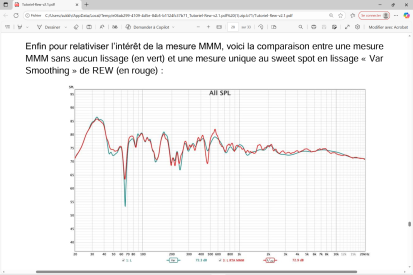FargateOne
Member
Thread Starter
- Joined
- Jun 5, 2017
- Posts
- 296
More
- Preamp, Processor or Receiver
- Rotel RSX-1562
- Additional Amp
- Bryston 3B3 for fronts mains
- Universal / Blu-ray / CD Player
- Cambridge CXU
- Front Speakers
- B&W 804 D2
- Center Channel Speaker
- B&W HTM4D2
- Surround Speakers
- B&W 705
- Subwoofers
- SVS PC-2000 and SVS PC-2000 Pro
- Other Speakers
- 10 PEQ filters/channel in receiver with REW
- Video Display Device
- Samsung UN55ES8000
- Other Equipment
- miniDSP 2x4 HD
Hi,
I saw this video:
And I was surprised how fast they seem to move the mic.
I am only an amateur here, but I followed the following method instead:
https://mehlau.net/audio/room-correction-peq/index.html
Measure speaker response
Set RTA > Averages > forever
Hold the mic at the main listening position at ear height with the tip pointing either up or down. Click "Reset averaging" and start moving the mic slowly through the listening area at a speed not faster than about 10cm (4 inches) per second. Try to cover as many different points as possible within the listening area. The area should cover a volume of about 60cm (2ft) or wider around the main listening position to avoid over-optimization by EQ later on. After about 60 averages click save.

Which one is the best if any? Or do you have others methods about how to do that. Or is there a common "best practice"?
I compared "my" method with a 9 positions measurements I did with Rew for my 6 channels. If there were differences in the average 9 measures for one speaker or an other, it was trivial, IMHO.
I saw this video:
And I was surprised how fast they seem to move the mic.
I am only an amateur here, but I followed the following method instead:
https://mehlau.net/audio/room-correction-peq/index.html
Measure speaker response
Set RTA > Averages > forever
Hold the mic at the main listening position at ear height with the tip pointing either up or down. Click "Reset averaging" and start moving the mic slowly through the listening area at a speed not faster than about 10cm (4 inches) per second. Try to cover as many different points as possible within the listening area. The area should cover a volume of about 60cm (2ft) or wider around the main listening position to avoid over-optimization by EQ later on. After about 60 averages click save.
Which one is the best if any? Or do you have others methods about how to do that. Or is there a common "best practice"?
I compared "my" method with a 9 positions measurements I did with Rew for my 6 channels. If there were differences in the average 9 measures for one speaker or an other, it was trivial, IMHO.
Last edited:















